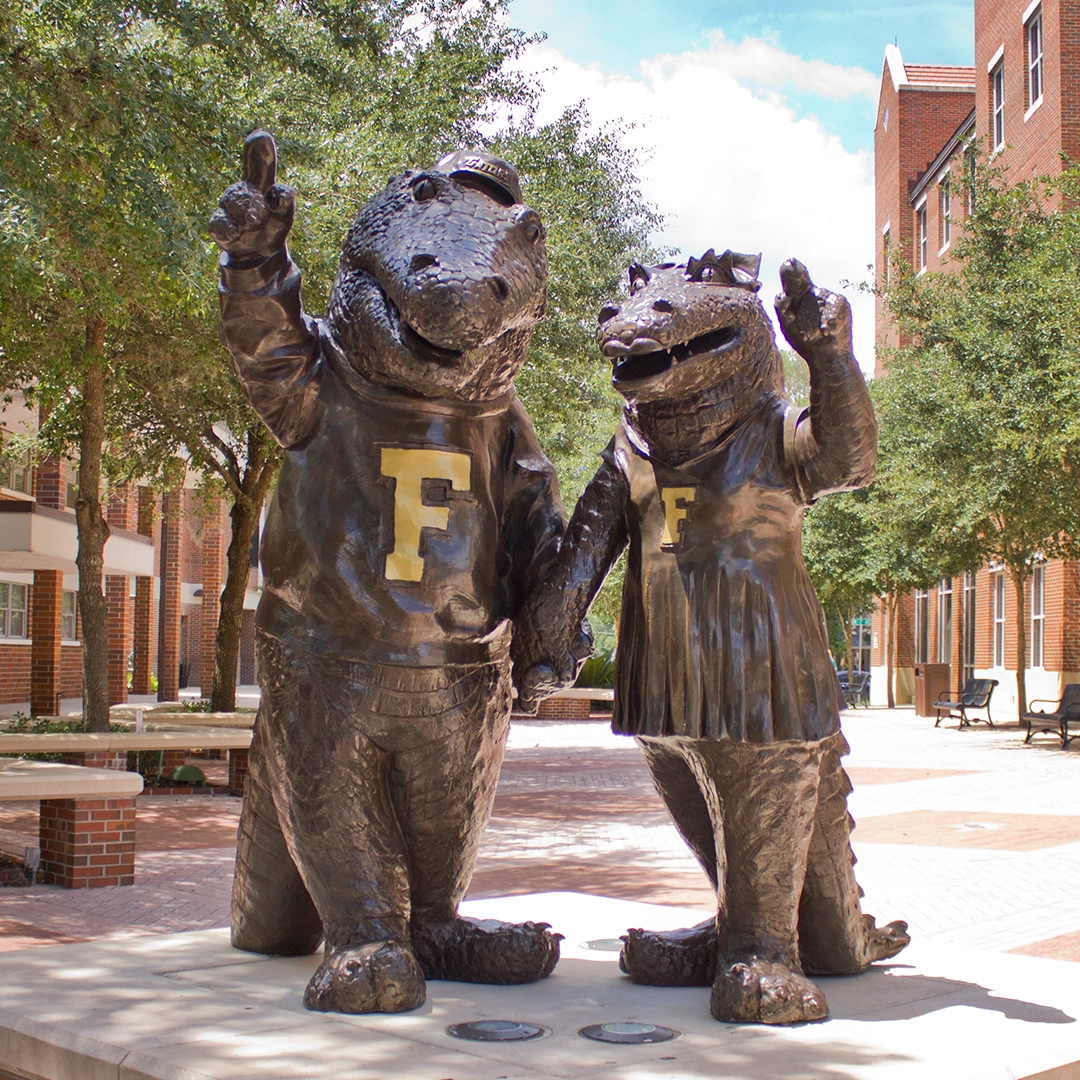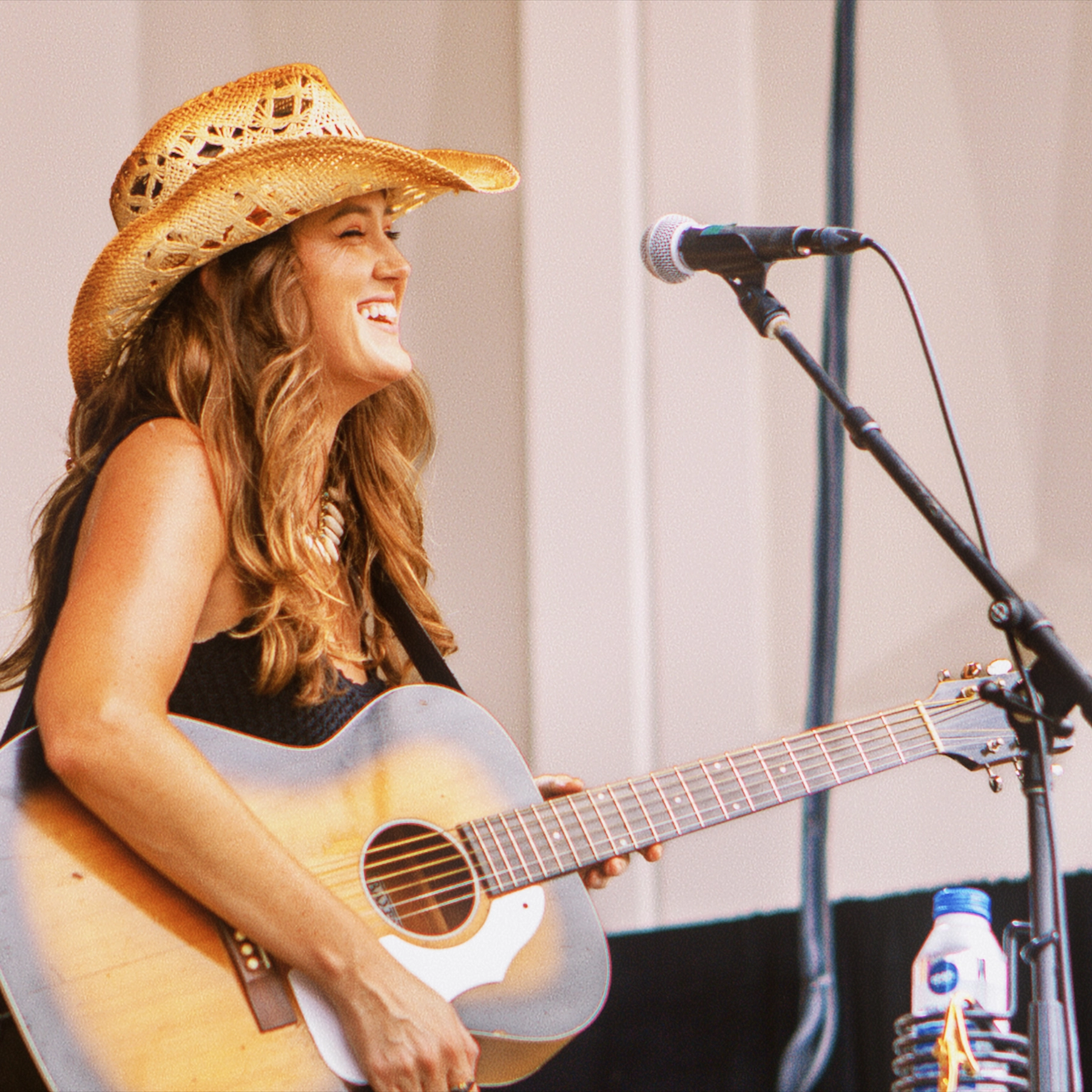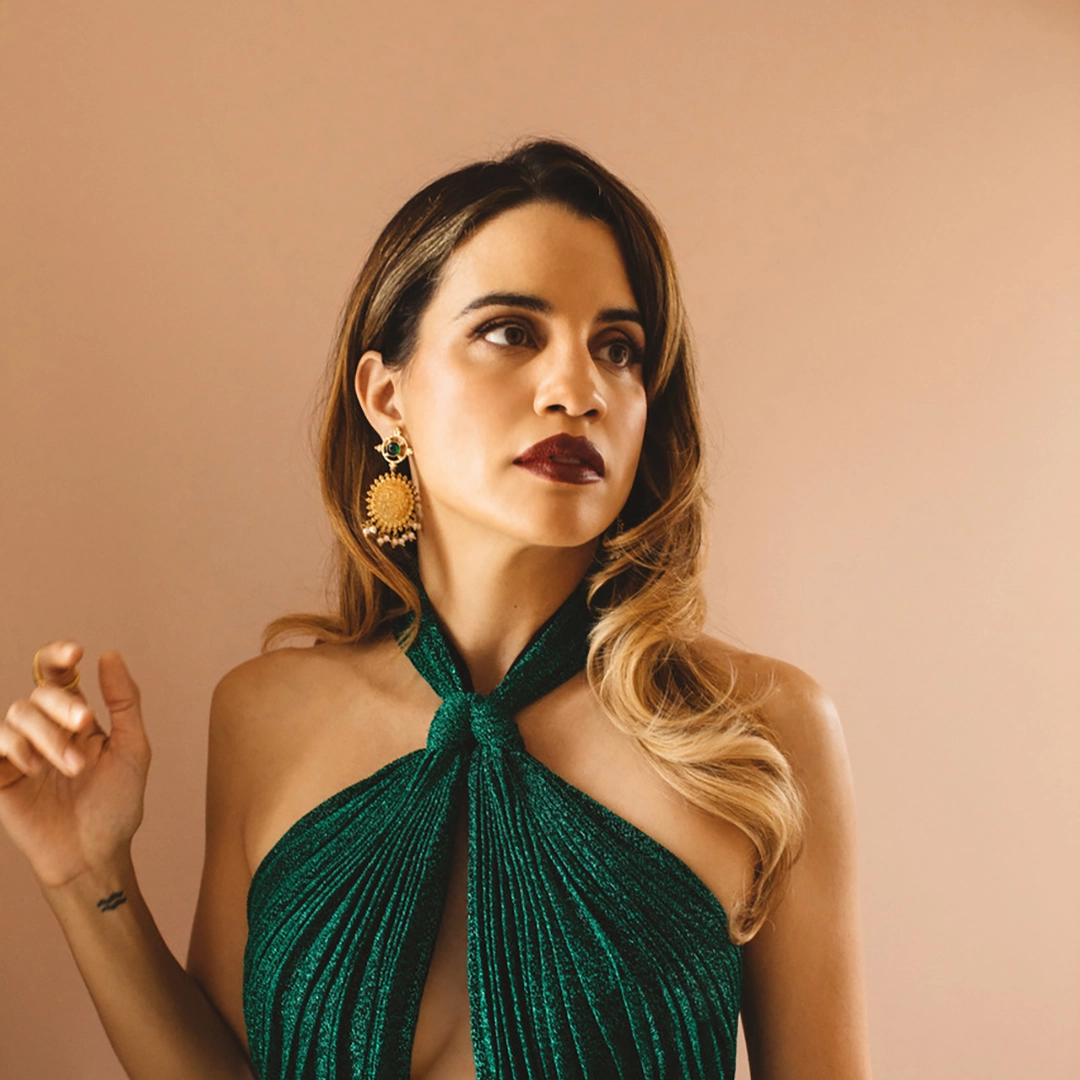by Avery Lotz | January 31, 2023
This Fearless Floridian is Breaking the Stereotype Around Black Surfers
Deyona Burton braves the waves–and people's ignorance—to connect with a sea that shaped Black history.
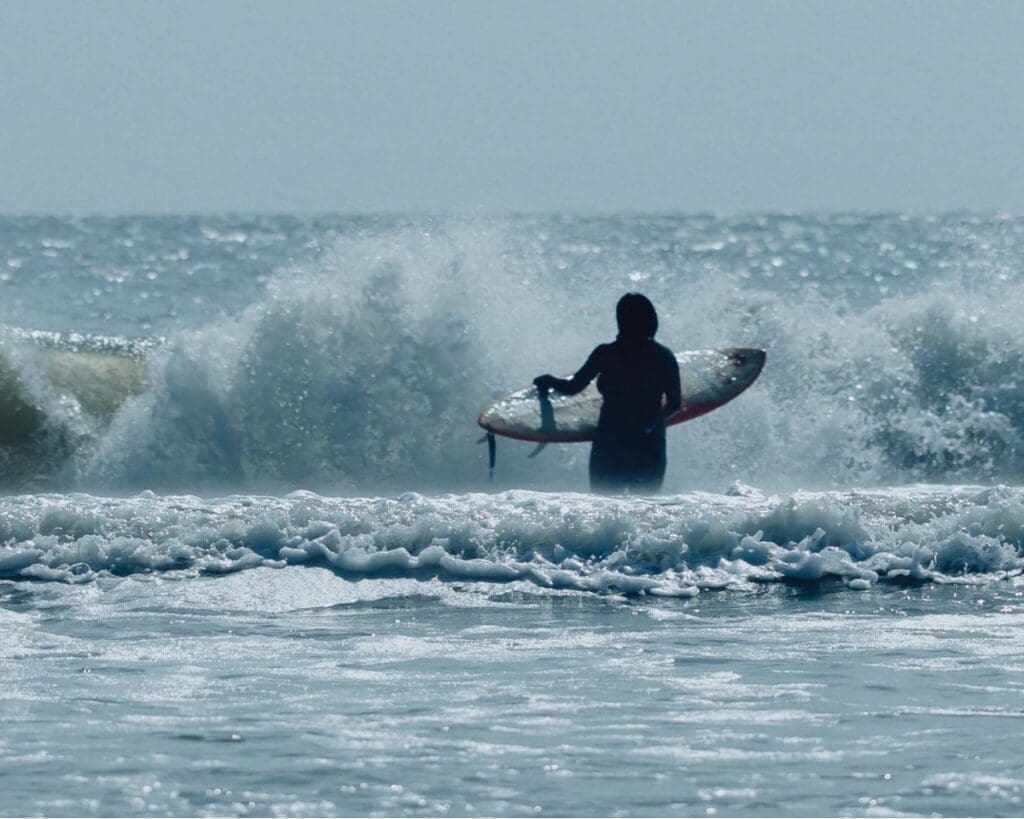
Deyona Burton inhales the salt-soaked breeze, soothed under the mid-morning sun. She strolls through the parking lot of American Beach to her Honda, nicknamed Yolanda, and plucks from it her hibiscus-adorned surfboard.
Her shiny black braid swishes against her bikini straps. She wishes the surf would leave her silky strands alone, but the billowing breakers always manage to tangle her hair, a nuisance she has grown to accept over the years. Standing here on historic sand, she eyes the ripples on the Atlantic’s glassy expanse.
The waves are small on this day, but for Burton, the ocean can be menacing in ways most surfers never experience.
“Oooh, that’s cold,” she sings as she paddles out.
Past the sandbar and the shorebreak, Burton straddles her board. She stands tall in this moment. But surfing has never been a glamorous sport. Not for anyone. You fall. You get up. You try again. You eat sand. But for Burton, the struggle has meant so much more.
This story was reprinted as part of Flamingo‘s partnership with Atrium, the University of Florida’s narrative nonfiction literary magazine.
The stereotype of the blond-haired, blue-eyed male surfer exists for a reason. Not many surfers look like Burton. Out here, in the sea, she has to hope she will get no questions, no stares. Even now, in a new era of watersports with women of color breaking barriers, generational trauma and the impacts of segregation linger.
In 2016, Simone Manuel became the first African American woman to win Olympic gold in an individual swimming event. South African surfer Michael February, one of few Black surfers on the World Surf League tour, formed JUJU Surf Club in 2020 to make the sport accessible for African youth. Here in Florida, Black surfer GiGi Lucas summons girls of color to the surf through her organization, SurfearNEGRA. Yet Burton remains a rarity.
Only 1% of swimmers registered with USA Swimming are African American. As of press time, there is not a single Black American surfer on the World Surf League championship tour. Black youth don’t get to see a reflection of themselves on television, carving waves and winning medals.
Burton lives in the echo of America’s racist past — and still hears its roar. She marched on the streets during the 2020 Black Lives Matter protests. She led the charge to strike the namesake of her Jacksonville high school: Robert E. Lee. And even on the water, she is determined to ride on.
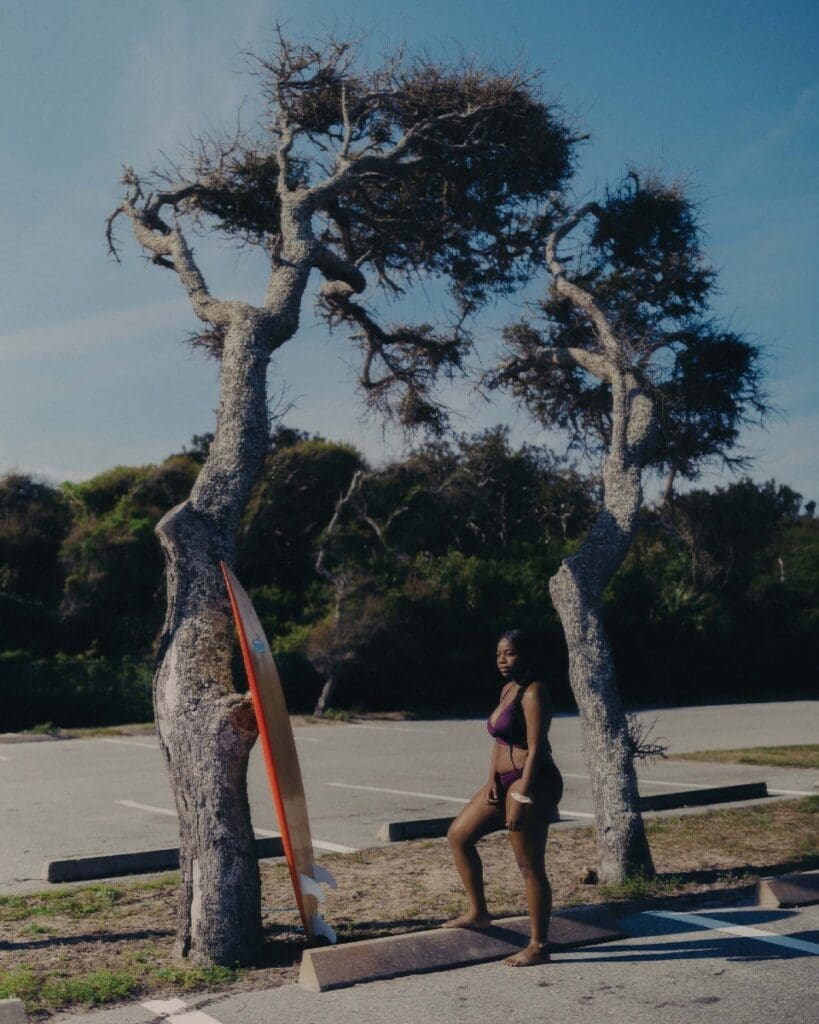
Sanctuary in the Sea
Nearly four years ago, the sea broke a young Burton’s heart. She had yet to form a symbiotic relationship with the waves.
In 2019, Burton, then only 16, found herself in a surf camp in Jacksonville, and the waves she grew up swimming in felt foreign. Her green and blue soft-top surfboard twirled through the air. She submerged herself below the bubbling foam. Her cheeks burned with embarrassment despite the cool kiss of the water.
Then she peeked above the surface. Her eyes bounced around the beach. Did anyone see her fall?
She slipped, nosedived or ate sand every time she tried to stand on the board. She would never do this again, she decided. Why did her mother encourage her to go to surf camp? She was older than the other campers—and the only Black person.
A child small enough to be 3 or 4 zipped by her, his white legs bent in an L as he carved an S in the face of the wave.
“Don’t worry,” a camp counselor said, gesturing to the pre-K kahunas paddling around her. “Their parents surf; they grew up doing this.”
He meant to comfort her. Instead, his words stung.
But she was not one to give up. The counselor’s words fueled her. She would try once more. She paddled for a wave.
Her hands sunk into the foam top of the board. The nose began to plummet in a beeline toward the unforgiving sand. Her strained knees wobbled.
Again, she crashed into a somersault beneath relentless foam. The ocean dumped her in the shorebreak, where she crumpled and brushed her fingers through her hair. The water left it drooping toward the ground.
The shoestring she wore—the only thing strong enough to contain her hair—snapped and floated into the salty ether.
She could hear her Nana’s words: “Don’t go out the house lookin’ any kind of way.”
Burton fumed. Between the sand in her one-piece and the lop-sided curls weighing down her head, she looked—and felt—some miserable kind of way. Black women, Burton believes, often feel pressure to exude flawlessness. In this moment, she felt so imperfect.
A white teenager approached her and extended a hand. In it was a hairbrush and a thin, cloth scrunchie.
“Tie your hair up,” she said.
Burton knew the scrunchie would break if stretched around her hair.
She realized the camper didn’t understand that the things that worked for her did not always work for Burton. That moment crystallized that she surfed in a sea where just decades before, Black people had been barred from the beaches. A sea by which enslaved African ancestors arrived in America, and in which many of them drowned. It was a sea that didn’t seem to welcome her.
But the ocean knows no color. The expanse of the salt water knows no walls, no barriers to entry. It was people who segregated the sea.
Documentary filmmaker Bruce Brown would have you believe that his white surfing subjects inspired “the beginning of surfing in Ghana.” In the film, “The Endless Summer,” surfers Michael Hynson and Robert August beckon Ghanaian children into the lively ocean and push them into waves on their 10-foot, 60s-style longboards.
That moment crystallized that she surfed in a sea where just decades before, Black people had been barred from the beaches. A sea by which enslaved African ancestors arrived in America, and in which many of them drowned.
But Brown was about 300 years late; it was no sandy-haired Californian who acquainted Ghanaians to the ocean.
Seventeenth-century African men, women and children swayed with Gold Coast waves. While white Europeans often refused to immerse themselves in water, African children submerged their heads without fear.
They played games for hours, pretending to be sharks and victims. The veil of fantasy evaporated when their fathers tore through the ocean beside them on canoes. The muscles beneath their skin stretched and contracted, yet their minds held strong; They could read the tides. To them, water was not merely a resource. The sea was part of society — and the people part of the sea.
In 1640, Michael Hemmersam, a German merchant, scribbled observations beneath a boiling African sun, struck by a foreign sight. In 1679, Jean Barbot, a French traveler, witnessed the same activity in Ghanaian waters.
A child held a bit of wood against their body and bobbed with the rhythm of coastal waters. A building wave approached them, roaring forward with foamy eyes locked on the shore. Then, the child flew.
Hemmersam’s and Barbot’s writings were some of the first accounts of surfing.
Even in the Americas, African aquatic culture persisted despite the slave trade. One enslaved man, known only as Richard, navigated Louisiana bayous to see his wife, Betty, who was held on a plantation on the other side. He was beaten for their visits, though the torture did not deter him.
Emancipation and subsequent segregation pushed Black Americans farther from the water.
In segregated America, few beaches were open to Black people. Bruce’s Beach in California and American Beach in Florida are two of the most famous African American beaches, but their fight to survive has not been all sunshine and serenity.
American Beach, 200 acres of beachfront land on Amelia Island now dotted with million-dollar homes and luxury hotels, was a haven for Black beachgoers to relax with dignity in the mid-20th century. But Hurricane Dora ravaged the area in 1964. And in its aftermath came the weight of expensive development.
Kevin Dawson, a historian focusing on the African diaspora and an associate professor at the University of California Merced, uncovered these aquatic gems of African history and proved that for those of African descent, a barrier from the surfing community didn’t always exist.
He thinks more recent history—including lynchings over rivers and Black bodies like Emmett Till’s found within them—further forged the disparity in water sports. Dawson sees Black people avoid the water today due to a historic lack of access to proper facilities or bathing suits. And disinformation plagued Black communities. Lies that Black people were more likely to drown because of denser bones proliferated through the early 2000s, spread by organizations like the U.S. Marine Corps and the Centers for Disease Control and Prevention.
Dawson uncovered the history of African surfing through over a decade of research for his book “Undercurrents of Power,” but he has also lived the loneliness of being a Black surfer.
Dawson, now 48, first saw a man streak over the sea around age 4 or 5 at the Laguna Beach basketball courts with his father. While his dad, a Harlem-born man standing at 6-foot-5-inches, placed the basketball atop the rim, Dawson watched a stranger being barreled on his surfboard by a collapsing wave. He wanted to chase that feeling of stoke.
Around a year later, Dawson felt the sting of racism in the water for the first time.
He waded at the ocean’s edge in Long Beach. He wore a tie-dye speedo, and his growing afro formed a halo around his head.
An older boy approached him.
“Colored people don’t swim,” he said.
Dawson debunked the claim by walloping the older boy in a swimming race. But the remarks continued.
As a teen, he frequented the bus that snaked down Artesia Boulevard to Santa Monica Bay where he surfed 15-foot winter swells. Noticing his surfboard, African American riders echoed the white boy’s sentiment: “Black people don’t surf.”
White people assumed he couldn’t surf. Black people assumed he was kidding when he said he did.
Often, while paddling for waves in Huntington Beach, he’d be forced to pull away from a ride. A flash of white skin would zip by him, snaking his wave. Dawson had priority. But he watched white shoulders disappear behind the curved back of waves that should have been his.
Other surfers might say this was bad surfer etiquette. But Dawson knew it was more than a novice mistake.
Occasionally, he challenged those violators. The responses were predictable:
“Where are you from?”
“You don’t have a right to be here.”
A racial slur.
But Dawson knew the ocean belonged to no one. So he spent 10 years proving it—searching through Caribbean, European and American archives. Constructing canoes in Africa without modern tools. Wading into the sea with African traditional octopus poachers. Talking, learning, observing.
Dawson broke out of the air-conditioned libraries where history was bound and became one with the beaches where history was made. He followed the currents.
Yet despite his findings, despite the roots of African aquatic sports, fear can still overshadow history.
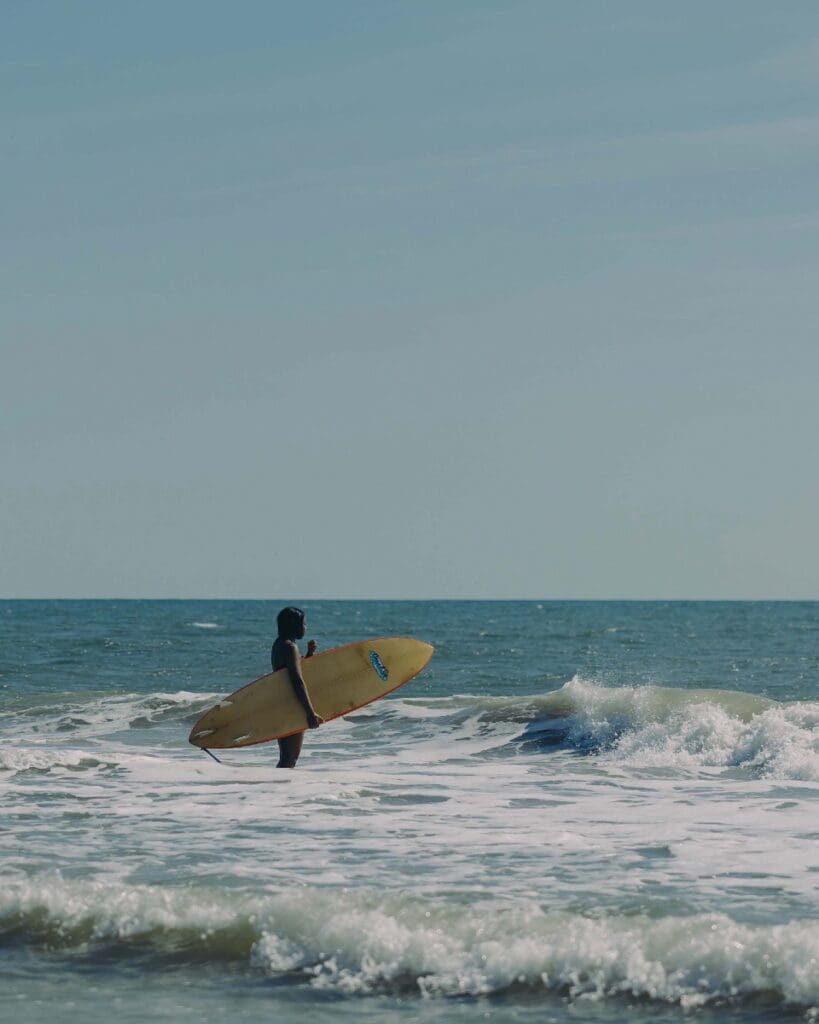
A Chance to Dream Again
Burton knew some things, from trauma to tradition, can be passed down through families. She knew some of her Black friends rarely went to the beach or dove in a pool. It wasn’t an oasis for them.
But she didn’t know that the apprehension toward the sea swelled even through her own blood.
Throughout Burton’s childhood, the beach was not a foreign place. Rather, she and her brother found solace in the sea.
On Jacksonville summer days when Burton was about 8 and her brother 2, their mother, Shakera Bailey, would hold a towel in the wind, letting the breeze flatten it before placing her resting spot on the sand. Bailey unpacked snacks for her two kids and a book for herself. By the time she settled, Bailey’s toddler son already embarked on a mad dash for the waves, his tiny legs a blur.
“Deyona, go get him,” Bailey would say, gesturing to Burton’s semi-aquatic brother.
“He’s your son,” a pre-teen Burton replied.
“He’s your brother,” Bailey answered.
Burton stifled her frustration and jogged to the shoreline on reluctant feet before her brother flopped into the blue-green vastness.
It wasn’t that Bailey didn’t care. Over the years, she waded up to her knees to snap pictures of her own children in the waves. She lugged her children’s surfboards down the beach. She was involved in their schools, in their camps, in their dreams.
But Burton didn’t understand why it always had to be her who chased the pint-sized son of Poseidon. Burton knew her grandmother was raised in the segregated South that kept her from watery fun. Was mom afraid of the water like Nana?
The first CDC report on drowning disparities showed that between 1999 and 2010, Black children between the ages of 11 and 12 were 10 times more likely to drown in a swimming pool than their white peers.
Two years ago, Bailey answered that question. She revealed she was taking lessons to learn to swim at the YMCA — something she never could do as a child.
Burton knew three generations of women in her family who didn’t swim. Burton and her mother, later in life, ended that cycle. Together, they teach other Black children, from her cousins to participants in surfing camps, to take to the waves.
But for many Black families, the obstacles persist. The USA Swimming Foundation found in 2019 that 64% of Black children have little or no swimming capabilities. The first CDC report on drowning disparities showed that between 1999 and 2010, Black children between the ages of 11 and 12 were 10 times more likely to drown in a swimming pool than their white peers.
Thaddeus Gamory, a director for Diversity in Aquatics—a network that aims to educate underrepresented communities on water safety—and president of the SWIMS Foundation, has watched the number of drowning deaths fluctuate annually. Before the pandemic, drowning rates among children plummeted. In 2021, the trend reversed. Florida set its highest record of childhood drowning incidents that year.
But sometimes, in profound pockets of joy, Gamory witnesses the water become a place of fun instead of fear.
At a water safety event in South Florida, Gamory watched young people splash and kick through the pool. The smell of chlorine wafted around him. As a lifelong swimmer, he felt at home.
Gamory noticed one elderly African American woman standing far from the deck surrounding the blue oasis. She monitored a group of children swimming with one of the white instructors.
“Come on in,” the instructor called. She refused.
Again, he jokingly hollered to her: “You’re not gonna drown!”
Gamory watched as the woman’s eyes glazed with tears and her lip quivered with fear. He approached her.
“Woah, what’s going on?” he asked.
“I’m so afraid of the water that I can’t even stand on the pool deck,” she said. “When you joke about drowning to me, you trigger something.”
“The fear is real, and I understand your response,” he said after apologizing, “but I hope to restore you today.”
He told her he understood the generational trauma anchored to living as a Black person in America. Then, he asked her to do one thing: to walk on the pool deck with him.
She grabbed his arm, her fingers digging in until his skin stung. He didn’t care about the pain—he believed the pain she felt inside was worse than the burning on his forearm.
After walking 30 feet in tiny steps, the pair reached the pool deck. Gamory’s bald head and broad shoulders loomed above her as she watched the scared two-dimensional woman on the rippling water’s surface.
“Just look at how calm that water is,” he said. “That water is not there to hurt you.”
She released him, her muscles relaxing with her mind. She laughed.
“We can go,” he said. His work there was done.
“No,” she replied. “I want to touch the water.”
She lowered herself onto her knees and reached down at the water. With one finger, she sent small waves through her reflection. Her grandkids, who never knew she was afraid, watched and giggled from the pool as she played like a child at the water’s edge.
Yet Gamory says there is only so much nonprofits and advocacy groups can accomplish. It was state and federal regulations that forbade Black people from the water and evoked wade-ins from Chicago to Miami.
While governments may not recognize their role in combating stereotypes and generational pain, swimmers, surfers and activists nationwide have found a remedy for the alienation of being a person of color in the water: community.
The Embrace of Togetherness

Burton felt discouraged after the first few days of her 2019 surf camp. But the waves kept building—and her mother continued to force her to attend.
Burton lugged the board back up the beach.
“Why is this thing called a soft top if it’s so heavy?” she grumbled.
She felt a stranger’s presence beside her. The agitated sentiments piling in her brain paused. Black braids spilled over the woman’s shoulders. Her smile was gentle, but humor sparkled in her brown eyes.
“Are you having fun?” she asked.
“No,” Burton replied shortly.
“Well, I surf,” the woman said.
“Really?” Burton asked. This woman looks like me.
The stranger on the beach became her surf instructor, her mentor and her friend: GiGi Lucas, the founder of SurfearNEGRA. But that day, she was just a random occurrence — a cosmic messenger of serendipitous sorts. Later, Lucas would give Burton her first surfboard: the flower-decorated shortboard she rides today.
For days, the ocean’s torment prevailed. Burton would be snatched by a rolling blue hill, yet when she tried to pop up like she practiced on land, she’d slip. She’d tumble. She’d inhale salt water.
The falls seemed to hurt less and less now that she wasn’t alone.
She doesn’t remember how many days it took, but the summer sun soared and set multiple times that week before Burton earned her first wave. That first wave could never wash away generations of painful history.
But it marked the coming of a new tide.
The small wave seized her with disproportionate power, just like all the other ones. From her stomach, Burton slid to her knees.
Her feet found solid ground while a translucent highway blurred beneath her.
For 10 seconds, Burton was a statue on the board; she felt like the beautiful Black woman on the beach. She didn’t care about her dripping hair. She didn’t care about the water stinging her eyes. She forgot about the times she fell. She forgot about the toddlers in the water.
“I did it! I did it!” she screamed. Distracted by her excitement, she fell to the side, splashing beneath the wave. But this time, she broke the water with fearlessness.
After harnessing the power of a wave for the first time, she became a surfer.
Burton says surfing is where choice and chance intersect. She chose to return to the water, and the ocean gave her a chance to do what her Nana could not.
At American Beach, Burton has generations of Black beachgoers with her; their spirits ride with her on the waves.
When she surfs alone, without her usual SurfearNEGRA squad, she paddles far enough away from others to avoid unnecessary questions.
“When did you start to surf? Where did you get that board?” white surfers ask.
No one else on the beach has to hear the accusatory you. But she remains unapologetic for her presence.
Years ago, she collected sand from American Beach in a vial. She used to carry it with her for luck and as a reminder of her strength and community.
Today, it sits on her dresser in her Florida State University dorm room, guarding her as she dreams of a day when she will be a force to reckon with — a current of change. A part of another changing tide.
Atrium, the University of Florida’s first and only narrative nonfiction magazine, aims to share true stories from Florida that are deeply reported and artfully told. Atrium focuses on issues important or unique to the Sunshine State—from the environment to changing demographics to racial justice. The magazine tells compelling stories of people whose voices have not always been heard and of communities that have been underserved through the written word, photography, video and more. Stay tuned for more stories from Flamingo’s partnership with Atrium.

